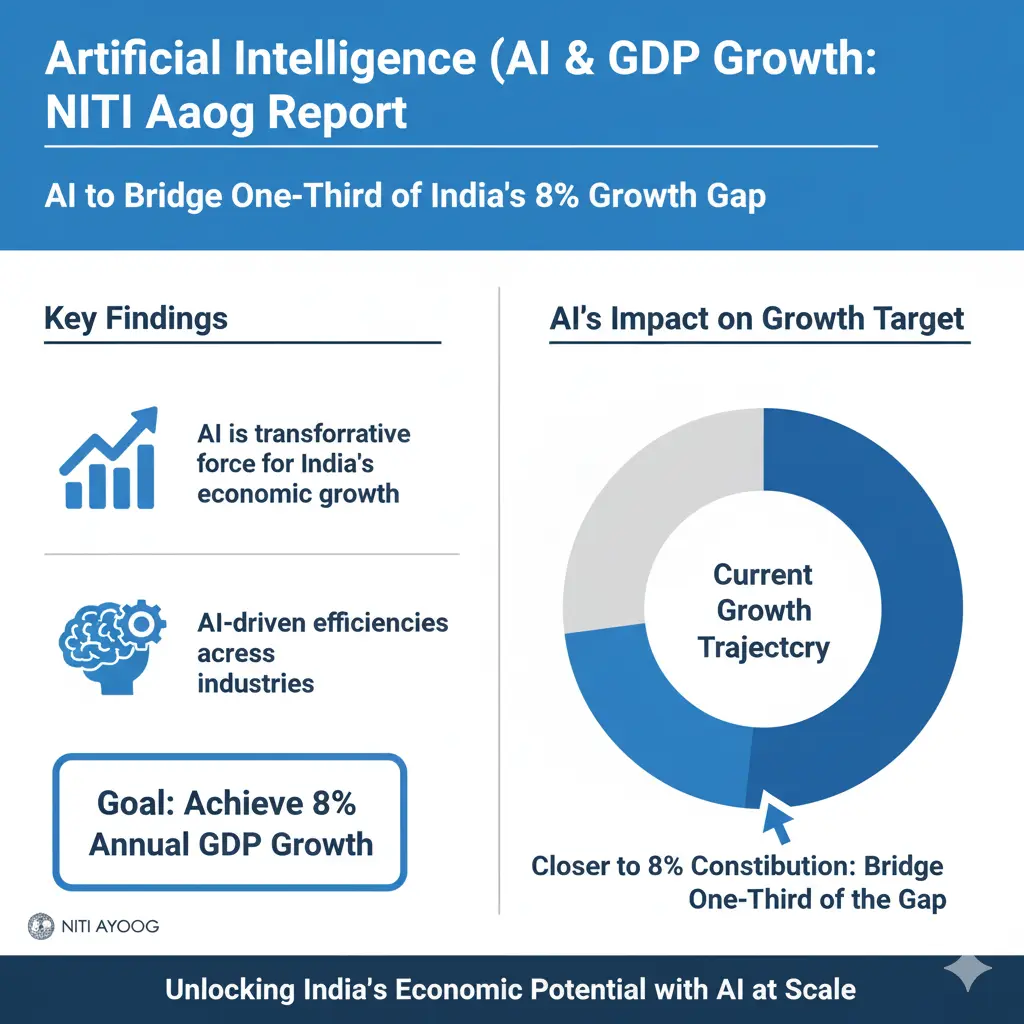September 16, 2025
Artificial Intelligence & GDP Growth: 7 Powerful Ways AI Can Boost India’s Economy
Artificial Intelligence (AI) & GDP Growth
NITI Aayog has released a report highlighting that Artificial Intelligence (AI) could play a transformative role in boosting India’s economic growth. According to the report, AI-driven efficiencies across industries can help India move closer to achieving an annual GDP growth rate of 8% in the coming years.
- The report mentions that by adopting AI at scale, India could bridge a significant portion—around one-third—of the current gap between the present growth trajectory and the 8% target. This underscores the potential of AI as a critical driver of future economic expansion.
AI’s Role in Industry Transformation:

- The report identifies several industries where AI can significantly improve productivity and reduce costs. These include pharmaceuticals, manufacturing, automobiles, and financial services.
- In pharmaceuticals, AI has dramatically changed drug discovery. It has reduced the cost of producing a new molecule by nearly ten times and cut down the typical drug development timeline, which usually takes about ten years, by approximately half.
- This creates an unprecedented opportunity for India to develop and introduce new drugs at the global level, positioning itself as a hub for pharmaceutical innovation.
- In manufacturing and automobiles, AI can optimize production processes, minimize waste, and improve quality control. In financial services, AI applications such as fraud detection, risk assessment, and personalized banking services can lead to greater efficiency and customer trust.
Strategic Importance for India:
- The report emphasizes that AI has the potential to not only transform the Indian economy but also shape the global economic landscape. Recognizing this, India must take proactive steps to establish itself as a global leader in AI development and deployment.
- To showcase India’s capabilities and build momentum, a significant event—the AI Impact Summit—is scheduled for February 2026, where global stakeholders will gather to discuss AI innovations and strategies.
Skilling and Workforce Transformation:
- While AI adoption offers tremendous opportunities, it also poses challenges, particularly in terms of workforce displacement. Many jobs may be disrupted or fundamentally changed by automation and AI-driven processes.
- The report stresses the need to prepare workers for this transition through continuous skill development. It recommends mapping job shifts annually to track which roles are declining and which new ones are emerging. It also highlights the importance of embedding lifelong learning into career pathways, enabling workers to continuously upgrade their skills.
- Special focus should be placed on digital upskilling for Micro, Small, and Medium Enterprises (MSMEs), which form the backbone of India’s economy. Protecting the interests of gig and platform workers, who are particularly vulnerable to technological disruption, is also vital. This can be achieved through safety nets, training programs, and policy support.
Vision Ahead:
- The report envisions a future where AI becomes a core driver of India’s economic transformation. With proper planning, India can harness AI to create new industries, improve global competitiveness, and secure its position as a technology leader.
- However, this requires a balance between innovation and inclusion. While industries adopt AI for greater productivity, the government and private sector must work together to ensure that workers are not left behind. Investments in skill development, policy frameworks for ethical AI use, and support for vulnerable sectors will be crucial.
- By strategically leveraging AI, India can accelerate growth, drive innovation, and emerge as a central player in shaping the next phase of the global economy.
Gist of Daily News Papers Articles/The Hindu /Indian Express-16 Sep 2025
September 16, 2025
Daily The Hindu/ Article Gist : 15 Sep 2025
September 15, 2025
Daily the Hindu/Indian Express Articles/Gist: 9 Sep 2025
September 9, 2025
Daily Gist of Article/ Editorial/News/Hindu/Indian Express
September 8, 2025
GIST OF DAILY ARTICLES THE HINDU/INDIAN EXPRESS : 4 sep 2025
September 4, 2025
